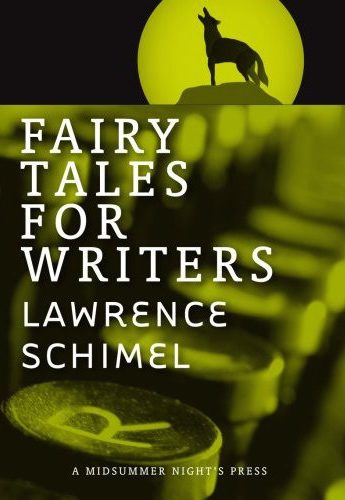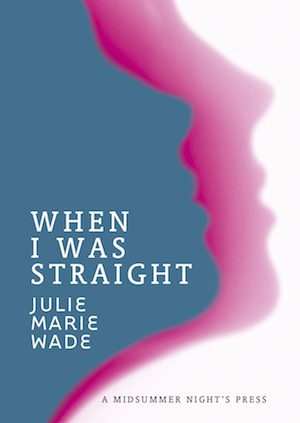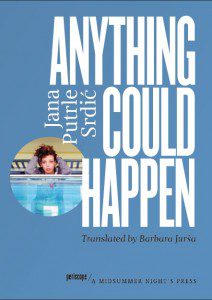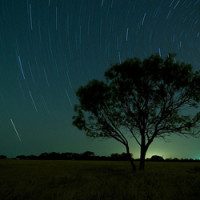A Midsummer Night’s Press was founded by Lawrence Schimel in New Haven, CT in 1991. Using a letterpress, it published broadsides of poems by Nancy Willard, Joe Haldeman, and Jane Yolen, among others, in signed, limited editions of 126 copies, numbered 1-100 and lettered A-Z. In 1993, the publisher moved to New York and the press went on hiatus until 2007, when it began publishing perfect-bound, commercially-printed books, primarily under three imprints: Fabula Rasa, Body Language, and Periscope.
***
Remember the good old days of Show and Tell? It was the perfect activity for every kind of learner. The visual learners got to fix their eyes on something, the auditory learners got to hear all about it, and the kinesthetic learners got to hold it in their hands when the teacher said, “It’s time to pass your show-and-tells around.”
Book reviewing is one aspect of my life where that thirty-year love of Show and Tell is most deeply gratified. After all, if you love a book, what’s better than showing it to someone, telling them why you love it, and then placing it into their hands so they can admire the book for themselves?
I was on the receiving end of a terrific Show and Tell back in 2009 when a mysterious package arrived in my mailbox at the University of Louisville. I was a PhD student then, teaching undergraduate Humanities courses on fellowship for the University. During the second year of my program, I had been assigned to teach a course called “Creativity & the Arts.” The only real requirement was to ensure that students experienced the arts in an interdisciplinary way. Everyone I knew who had taught the course approached it differently, but all seemed to agree on the need to knit the various disciplines together by choosing a unifying thread.
When I opened the package, two small books dropped onto the counter. They were light and perfect-bound, vividly colored and ideally sized for slipping in a purse or pocket. One was called Fairy Tales for Writers by Lawrence Schimel, the other Fortune’s Lover: A Book of Tarot Poems by Rachel Pollack. I stood right there blocking the doorway, reading. Each book proved as pithy as it was aesthetically pleasing. If I were to judge these books by their covers, I would have said they were magical, compelling, and inspired. It turned out the covers didn’t lie.
But here’s the most magical part: I hadn’t told anyone that the unifying thread I had chosen for my inaugural Creativity & the Arts class was myths and fairy tales. And then these books fell, seemingly out of the sky and into my pedagogical lap, the week I was to meet my students. Was it serendipity or something more? I studied the return address: A Midsummer Night’s Press, New York City. I had never heard of the press before, but it was on my radar now. And I was ready, my Show and Tell in hand, to introduce my first Creativity & the Arts students to our first models for literary emulation.
Exhibit A: The Fabula Rasa Imprint:
Fairy Tales for Writers, Fortune’s Lover, and several other books released in the coming years, belong to an imprint of A Midsummer Night’s Press called Fabula Rasa. I want to tell you about them first, and then I want to show you, with the help of the Internet, what this series is all about.  Each book is “devoted to works inspired by mythology, folklore, and fairy tales.” Even the title of the imprint is enchanting. Most of us remember John Locke and the tabula rasa, a Latin phrase often simply translated as “blank slate.” Locke believed our experiences and perceptions of the world, rather than any inborn mechanism or script, dictated what we ultimately came to know and believe. Humans, in his view, were “written upon” by life. And we become texts of the world ourselves, at least in part, because of the stories we are told about it—the myths and folklore that comprise our earliest bedtime tales and linger throughout our lives.
Each book is “devoted to works inspired by mythology, folklore, and fairy tales.” Even the title of the imprint is enchanting. Most of us remember John Locke and the tabula rasa, a Latin phrase often simply translated as “blank slate.” Locke believed our experiences and perceptions of the world, rather than any inborn mechanism or script, dictated what we ultimately came to know and believe. Humans, in his view, were “written upon” by life. And we become texts of the world ourselves, at least in part, because of the stories we are told about it—the myths and folklore that comprise our earliest bedtime tales and linger throughout our lives.
Those who go on to make art in any discipline become mythmakers and folklorists at large—fabulists, we might say. They begin to decorate the once-blank slate of experience with the materials of their chosen medium. Their books and canvases and sculptures and photographs and sheets of music are the fabula rasa, and Lawrence Schimel, Rachel Pollack, Francesca Lia Block, Jane Yolen, and Roz Kaveney are the fabulists at work (to date) at A Midsummer Night’s Press on this series. The collective spirit of the imprint is best captured by the title of Kaveney’s book, released in 2012: What If What’s Imagined Were All True. It’s an exceptional generation prompt for artists of any discipline, too. Try it some time. Share it with your students.
*
Now flash-forward, the way a fabulist would, to late 2011/early 2012. I was closing in on my PhD when a large box arrived on my doorstep. This time the package was anticipated, as I had been invited to join the panel of judges who would award the Lambda Literary Award for Lesbian Poetry that year.
I unpacked the books, one at a time, and there at the bottom of the box I found one of these small, perfect-bound, vividly colored, pleasing-to-the-eye-and-hand volumes that could only be an A Midsummer Night’s Press publication. The book was titled Milk and Honey: A Celebration of Jewish Lesbian Poetry, and the cover featured two women drinking coffee in a bustling coffee shop. I wanted to pull up a chair and join them. But opening the book, I soon discovered, was the equivalent of pulling up a chair. The reader received an intimate invitation to the table and the many conversations underway.
Milk and Honey was an anthology, a paradoxically tiny book bursting at its commercially-bound seams with myriad voices. The poets represented therein spanned the gamut from emerging writers to established authors, and they sang in every register—from erotic whispers to empowered screams. This collection, edited by Julie R. Enszer, made the shortlist for the Lambda Literary Award by enthusiastic consensus, and it led me back to A Midsummer Night’s Press in search of this second imprint called Body Language.
The Body Language imprint is “devoted to texts exploring questions of gender and sexual identity,” and when I read the description, I made a wish: I wanted to write my own collection of compressed lyricism with Body Language in mind. At this time, I was also teaching an upper-level Humanities course cross-listed with Women’s & Gender studies. My course was designed with the University’s cultural diversity requirement in mind, “considering diverse subject positions in relation to questions of gender and sexual identity.” Perhaps this was serendipity, or perhaps it was something more.
When I ordered the first book from the Body Language series—This is What Happened in Our Other Lives by Achy Obejas—I was seeking personal inspiration. I found that and then some. I found another title serving as a prompt, a catalyst for a dynamic class writing exercise and corresponding discussion. The back of the book bore three designations: Poetry/Latina Studies/Lesbian Studies. It was interdisciplinary. It was provocative. Obejas epitomized in her poetry what Cherrie Moraga had described when she wrote of “theories in the flesh.” My students could see how Obejas was instantiating Moraga’s concept of Chicana feminism in these poems; that is, “how the realities of [the speaker’s life]—[her] skin color, the land or concrete [she] grew up on, [her] sexual longings—all fuse[d ]to create a politic born out of necessity.” And that politic was embodied before us in this vibrant, lyrical form.
Exhibit B: The Body Language Imprint:
Flash-forward again, this time to 2014, when yours truly—a lucky post-doctoral poet—finds her own book published on the Body Language imprint. I don’t think serendipity even begins to cover it.
In one of the best Show-and-Tell scenarios I can imagine, the teacher decides who goes next by letting members of the class self-elect. After one student has a chance to share her artifact and pass it around, another student might raise his hand and say, “My artifact is related to hers because…” and so another round of Show and Tell begins.
Put another way, we write because we read, don’t we? I don’t believe we could or would if we didn’t, at least not half as well. And much of what we write finds its way to the page because of what we read. Here, I’ll show you what I mean:
 I was inspired to write the poems in When I Was Straight because of my close reading of and engagement with the poems of many writers, Denise Duhamel and Maureen Seaton most prominent among them. But I was inspired to shape and frame the collection as I did because of the accordion nature of the books I had read from A Midsummer Night’s Press. Each volume was compressed, and yet it enlarged immediately upon opening, brimming with bold sounds, assertions, and questions, stretching in such a way that it seemed impossible that all the images and ideas therein could be re-contained between those two pert covers.
I was inspired to write the poems in When I Was Straight because of my close reading of and engagement with the poems of many writers, Denise Duhamel and Maureen Seaton most prominent among them. But I was inspired to shape and frame the collection as I did because of the accordion nature of the books I had read from A Midsummer Night’s Press. Each volume was compressed, and yet it enlarged immediately upon opening, brimming with bold sounds, assertions, and questions, stretching in such a way that it seemed impossible that all the images and ideas therein could be re-contained between those two pert covers.
Achy Obejas, Brane Mozetič, Julie R. Enszer, Raymond Luczak, Roz Kaveney, David Bergman, Lawrence Schimel, and Michael Broder, have all shared artifacts on the Body Language imprint that make me want to raise my hand and extend the showing and telling once again: “My artifact relates to theirs because…” Because we are poets plumbing what it means to be queer in original and subversive ways. Because there are great joys and challenges in This Life Now. Because there is Handmade Love, a Dialectic of the Flesh, a Fortunate Light. Because, inevitably, there are also Banalities and Deleted Names, forces pressing for our erasure. Because there are occasions when we will find ourselves Mute, and others when we will find ourselves speaking louder than the crowd, occasions when we will proclaim at last: This is What Happened in Our Other Life.
*
This time let me show first before I tell:
Exhibit C: The Periscope Imprint:
See? If you were to judge these books by their covers, wouldn’t you say they were magical, compelling, and inspired. These covers don’t lie.
 Since November 2014, A Midsummer Night’s Press, under the continued guidance and innovation of Lawrence Schimel, has published three new books on the Periscope “Poets in Translation” series—One is None, written by Kätlin Kaldmaa and translated by Miriam McIlfatrick-Ksenofontov; Anything Could Happen, written by Jana Putrle Srdić and translated by Barbara Jurša; and Dissection, written by Care Santos and translated by Lawrence Schimel.
Since November 2014, A Midsummer Night’s Press, under the continued guidance and innovation of Lawrence Schimel, has published three new books on the Periscope “Poets in Translation” series—One is None, written by Kätlin Kaldmaa and translated by Miriam McIlfatrick-Ksenofontov; Anything Could Happen, written by Jana Putrle Srdić and translated by Barbara Jurša; and Dissection, written by Care Santos and translated by Lawrence Schimel.
One of Periscope’s central purposes, as Schimel explains, is “to bring the excellent work of women poets around the globe to a wider readership.” Toward this end, and with these first three volumes, he has sought translations of poets whose genders and languages are underrepresented in the world of translation and in the world of poetry at large.
This is going to sound like a fabulist account, but I tell you, it’s true. I once had a periscope of my own. It was a toy manufactured by Spy Tech, which my father gave me on my eleventh birthday. He understood how much I wanted to be a sleuth.
It wasn’t very discreet of me to bring my new periscope to Show and Tell, but I did it anyway. Of all my spy equipment, the periscope seemed the most mysterious and the most ingenious to me. How could I sit on my bedroom floor and peer around the corner at whatever was happening in the hall? How could I see so clearly into the next room without leaving the room I was in?
A strategically placed mirror creates this effect in a literal periscope. A diligently rendered translation creates the same effect in a literary periscope. The reader is allowed to see into languages and lives she would not otherwise be able to access, let alone explore.
My fifth-grade Show and Tell went something like this: “This is an amazing periscope that my dad gave me for gumshoeing at home and around the neighborhood.” [Big smile]  “You’re going to want to try it out, and you’re going to be stunned by the corners you can see around when you do.”
“You’re going to want to try it out, and you’re going to be stunned by the corners you can see around when you do.”
My new Show and Tell turns out to be a mirror image of the old one: “These books are amazing periscopes that Lawrence Schimel has given us for gumshoeing through our literary lives. We might think of our sleuthing mission now as an investigation of the things that make us human, of poetry, and of global women’s lives.” [Big smile] “You’re going to want to try them out, and you’re going to be stunned by the corners you can see around when you do.”
The teacher wouldn’t let every student have a turn with my periscope, so I had to demonstrate it just once for the whole class.
It has been almost twenty-five years, and I’m still here, showing and telling. This time I’m holding three periscopes at once in my hands.
Let’s peek inside One is None. I’ll show you one of my favorite passages:
My Bosnian lover has
a history of love.
As far as I know
he has loved a girl in a yellow skirt,
a boy in seventh grade
who sketched inconceivable spaces,
a dog with no name
(that’s why it was loved),
a woman who knew
how to sink into armchairs,
and a country
that blushed in a tongue of living fire.
Now let’s peek inside another one, Anything Could Happen. I’ll show you a few of the lines I love:
all times are apocalyptic
Wishing for a poem is like a humidity
in the air, 80% and rising.
like a big soft cat
(with a bird in its stomach)
sleeping on our breasts.
Let’s peek inside this one, too, over the spine and under the cover. I’ll show the titles I’m giving the students in my summer class, to spark their creative fire:
The Great Atlas of the Human Body
According to Wikipedia: “The action of the guillotine is so swift that the head remains conscious for up to thirty seconds after being severed.”
Model Punishment
Transylvania Effect
Death Will Come and It Will Have Your Eyes
You Win, Little Cat
***
I have told you what I can tell you, and I have shown you what I can show you. Now comes the best part. It’s time to pick up these books—any of them, all of them—and hold them in your very own hands.




